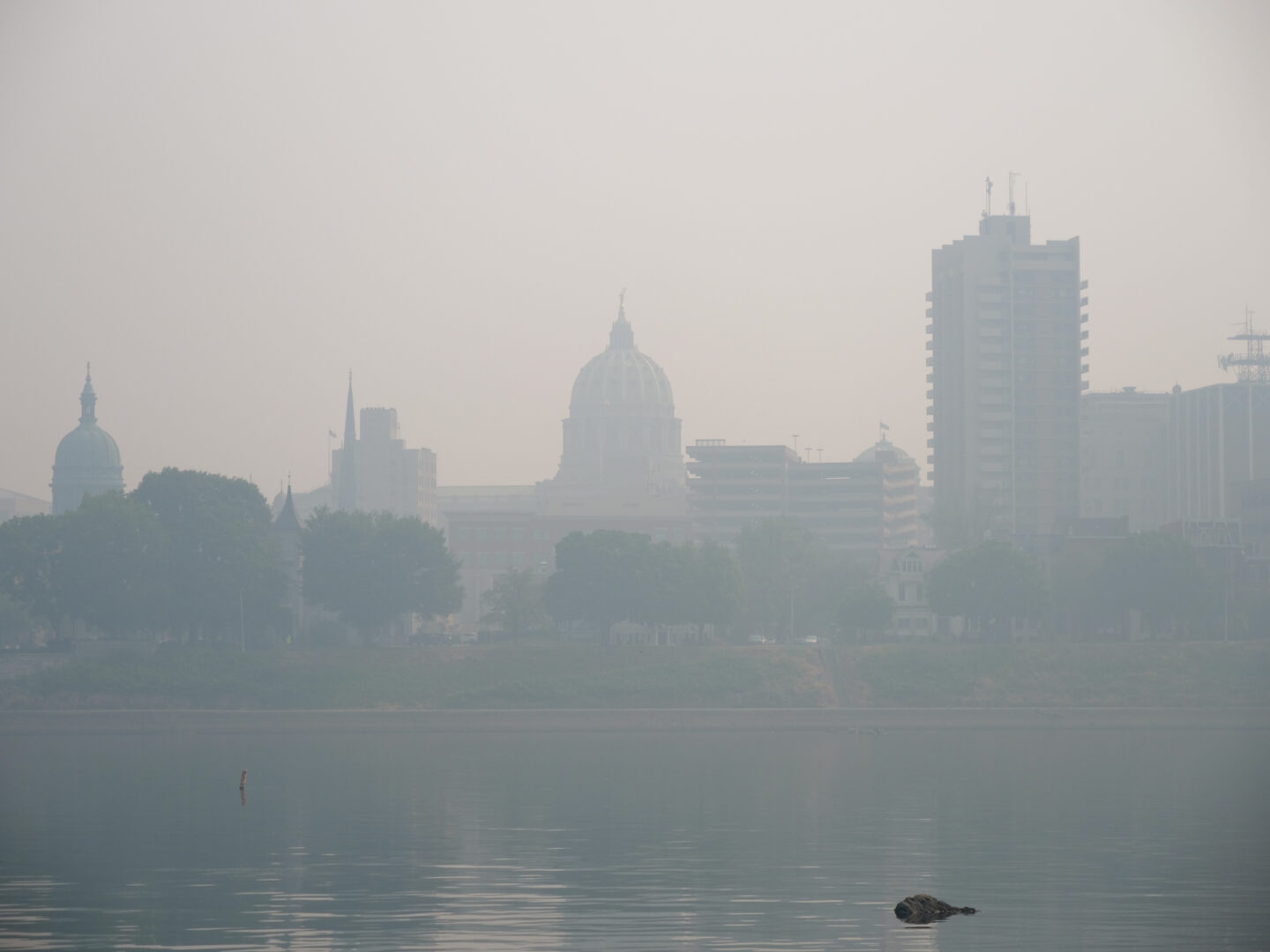
The state capitol building is shrouded in a haze as smoke from Canadian wildfires filtered into Pennsylvania on June 8, 2023. The smoke degraded air quality across Pennsylvania and other states in the northeast. Jeremy Long - WITF News


The state capitol building is shrouded in a haze as smoke from Canadian wildfires filtered into Pennsylvania on June 8, 2023. The smoke degraded air quality across Pennsylvania and other states in the northeast. Jeremy Long - WITF News

The state capitol building is shrouded in a haze as smoke from Canadian wildfires filtered into Pennsylvania on June 8, 2023. The smoke degraded air quality across Pennsylvania and other states in the northeast. Jeremy Long - WITF News
Central Pennsylvania communities have some of the unhealthiest air in the Mid-Atlantic region.
The American Lung Association’s latest State of the Air report ranked the Harrisburg-York-Lebanon metro area as the second-most polluted in the region for year-round fine particles, behind Pittsburgh. Johnstown and Lancaster ranked third and fourth, respectively.
The region includes Pennsylvania, Delaware, Maryland, New Jersey, Virginia, West Virginia, and the District of Columbia.
Fine particle pollution is made up of microscopic bits of ash, metals, dust or chemicals that can come from construction sites, power plants, transportation, and farming.
The particles embed deep in the lungs and can cross over to the bloodstream, where they can irritate heart conditions and raise the risk of heart attacks or strokes.
“The lungs don’t care what the source of the air pollution is. What they’re interested in is, ‘am I getting healthy air to breathe?’” said Kevin Stewart, environmental health director for the American Lung Association.
The 2024 report covers air quality data from 2020 to 2022.
It ranks metro areas based on the number of high ozone days, number of days with high particle pollution levels, and year-round averages of particle pollution.
Ground-level ozone is created when pollution reacts with sunlight. It can irritate respiratory conditions such as asthma.
Ozone has “been likened to searing lung tissue, like a sunburn would,” Stewart said.
Lancaster County improved in all three areas measured in the report. It’s improved from an F grade for ozone in the 2020 report to a B in this year’s. It got F grades for measures of both year-round and daily particle pollution levels. Lancaster ranked 30th-worst in the country for daily particle pollution, with 6.7 unhealthy days on average per year.
Efforts to combat local air pollution are held up by a lack of data.
Lancaster County’s Sierra Club chapter is placing ten PurpleAir monitors at volunteer’s homes in an attempt to improve data collection.
At a Sierra Club meeting April 17, County Commissioner Alice Yoder said the county is struggling with an increase in asthma cases over the last 10 years. She said mapping those cases in comparison to air quality data from the new monitors could give the county useful information.
The Harrisburg area earned a B grade for ozone, tying last year’s report. Its daily measure for particle pollution improved but it still earned a D grade.
Harrisburg earned an F for year-round particle pollution and ranked 37th-worst in the country for that measure.
Stewart said the failing grade is due, in part, because the federal government recently introduced more strict standards for healthy air. He noted Dauphin County’s F grade affected the rest of the metro area’s score.
In the report, the Philadelphia-Reading-Camden area improved for all three measures. It set a new record for best-ever values for ozone smog and year-round particle pollution. It also improved in ozone, but still earned a failing grade. Philadelphia is the worst-ranked metro in the Mid-Atlantic region for ozone smog.
The Scranton-Wilkes Barre area ranked among the cleanest in the nation for ozone levels for a second year. The area earned a B grade for daily particle pollution.
The Pittsburgh area was the worst in the Mid-Atlantic for both measures of particle pollution. It ranked in the worst 25 cities in the U.S. for year-round particle pollution. It’s third-worst in the Mid-Atlantic for ozone.
LNP/Lancaster Online staff writer Elizabeth DeOrnellas contributed to this report.
StateImpact Pennsylvania is a collaboration among WITF, WHYY, and the Allegheny Front. Reporters Reid Frazier, Rachel McDevitt and Susan Phillips cover the commonwealth’s energy economy. Read their reports on this site, and hear them on public radio stations across Pennsylvania.
(listed by story count)
StateImpact Pennsylvania is a collaboration among WITF, WHYY, and the Allegheny Front. Reporters Reid Frazier, Rachel McDevitt and Susan Phillips cover the commonwealth’s energy economy. Read their reports on this site, and hear them on public radio stations across Pennsylvania.
Climate Solutions, a collaboration of news organizations, educational institutions and a theater company, uses engagement, education and storytelling to help central Pennsylvanians toward climate change literacy, resilience and adaptation. Our work will amplify how people are finding solutions to the challenges presented by a warming world.